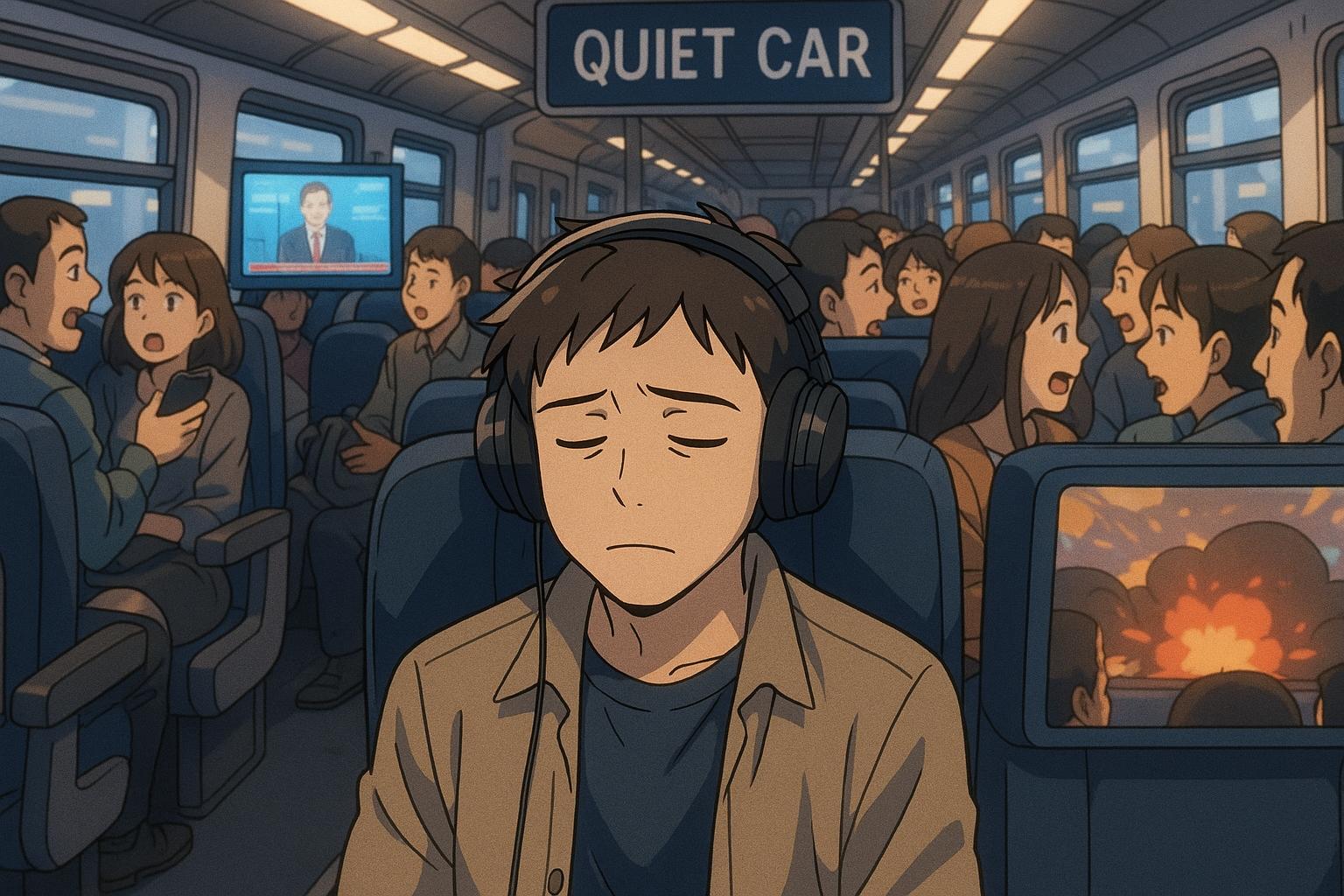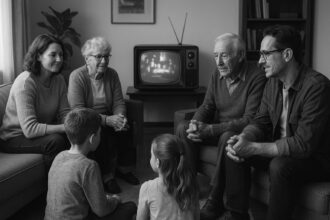Once sanctuaries of silence, quiet carriages on British trains are increasingly failing to provide peace amid loud devices and conversations, prompting calls for stricter enforcement and a rethink of their role in modern travel.
Train journeys are often accompanied by the expectation of a retreat from the cacophony of everyday life, particularly within the confines of designated quiet carriages. However, as some recent experiences suggest, these spaces have devolved into chaotic environments, frequently failing to fulfil their promise of serenity.
On any given trip, the illusion of peace can shatter with the jarring sounds of a child’s animated show blaring from a tablet or a fellow passenger engaged in a spirited conversation via loudspeaker. This dissonance raises significant questions about the efficacy and enforcement of quiet carriage regulations. The challenge lies in the subjective nature of “quiet”; what is tranquil to one passenger may be outright intrusive to another. This disparity often leads to discomfort—individuals cramped in a seemingly serene oasis while surrounded by the electronic hum of avaricious technology.
The quiet carriage originated in the 1990s as a sanctuary from the loud mobile phone conversations that were once a hallmark of train travel. It aimed to provide a respite for those seeking a moment of calm during their journey. Yet, as mobile usage has evolved—shifting from vocal communication to texting and streaming—these spaces have suffered a decline in both adherence and respect. A handful of train operators have abolished quiet carriages altogether, arguing that the nature of mobile device usage has mitigated the need.
This trend has only intensified since the pandemic. A surge in users engaging with their devices in public encompasses everything from music to videos, often without the consideration of neighbouring passengers. In a recent proposal from the Liberal Democrats, a £1,000 fine has been suggested for those refusing to wear headphones, highlighting the acute frustration stemming from this lack of etiquette. Observations from etiquette experts underline the need for communal respect in public spaces, endorsing the use of lower volumes and discouraging loud conversations, particularly in those areas designated as quiet.
Feedback from passengers on forums reflects a broader consensus: the challenge of regulating noise in these zones is exacerbated by the absence of strict enforcement. Train companies are quick to note that while they intend for quiet carriages to be serene, the enforcement relies heavily on the courtesy of commuters—an often unreliable approach given the myriad of personal definitions of what constitutes acceptable volume.
A study by Transport & Environment underscored the high costs associated with British rail travel, showing that passengers pay some of the highest fares in Europe. With these spiralling costs and a growing number of overcrowded trains, frustrations naturally escalate. When a single quiet carriage is sandwiched amongst several loud ones on a busy service, the unrealistic expectation of tranquillity can quickly dissolve. Families with young children or individuals who find themselves engrossed in loud conversations don’t necessarily intend to disrupt but are often left with few choices during their journey.
Ultimately, the quiet carriage may be rapidly becoming an anachronism in an era where personal devices and public spaces collide. What once served as a refuge is increasingly viewed as a source of irritation—raising the question of whether it is time to reconsider their existence entirely. For those still seeking a peaceful travel experience, the growing acceptance of noise-cancelling headphones may be a worthwhile investment, offering a more reliable escape from the clatter inherent in modern train travel.
As train operators and passengers navigate this evolving landscape, it seems evident that the concept of a quiet carriage may need a substantial reevaluation to align with contemporary commuting realities. For now, commuters might find some solace in accepting a new norm, adjusting their expectations, and perhaps learning to embrace the ambient sounds that accompany modern public transport.
Reference Map
- Core focus, experiences of quiet carriage disturbances
- Expectations and background on quiet zones
- Expert advice on train etiquette
- Passenger feedback and enforcement challenges
- Historical context of the quiet carriage
- Discussion about quiet zones’ purpose and effectiveness
- General perceptions and definitions of noise levels in quiet carriages
Source: Noah Wire Services
- https://www.independent.co.uk/life-style/train-quiet-carriage-rules-b2751454.html – Please view link – unable to able to access data
- https://www.greateranglia.co.uk/travel-information/your-journey/quiet-zone – Greater Anglia’s Quiet Zone is located in Coach M on Intercity trains between Norwich and London. Passengers are expected to refrain from phone calls, use electronic devices in silent mode, keep headphone volumes low, and engage in quiet conversations. Non-compliance may result in being asked to move to a different carriage. The Quiet Zone is a public space, not a silent one, so ambient noise cannot be entirely eliminated. Passengers sensitive to noise are advised to use noise-cancelling headphones or earplugs.
- https://www.thetrainline.com/en-us/via/europe/uk/england/a-guide-to-train-etiquette-with-william-hanson – Etiquette expert William Hanson provides guidance on train behavior, emphasizing respect for shared spaces. He advises passengers to keep window blinds in mutually acceptable positions, share armrests, and use allocated table areas. He also highlights the issue of ‘leaky’ headphones, where music played too loudly becomes audible to others, and suggests politely addressing the issue with fellow passengers. Additionally, he recommends keeping conversations civil and avoiding loud discussions, especially in designated quiet carriages.
- https://www.railforums.co.uk/threads/quiet-coaches-what-constitutes-unacceptable-noise.62692/ – A discussion on RailUK Forums explores the challenges of maintaining quiet in designated quiet carriages. Passengers share experiences of encountering noise disturbances, such as loud music and conversations, and question the enforcement of quiet carriage rules. Responses from train companies like East Coast Trains and Cross Country Trains indicate that while quiet carriages are intended to provide a peaceful environment, enforcement relies on passenger courtesy, as there are no specific railway by-laws to back up these policies.
- https://blisstulle.com/which-coach-is-the-quiet-coach-on-lner/ – An article on Bliss Tulle explains that on LNER trains, the Quiet Zone is typically in Coach B. Passengers in this carriage are expected to observe specific rules: no mobile phone calls, use of electronic devices in silent mode, keeping headphone volumes low, and conducting conversations quietly. The article also notes that while the Quiet Zone is intended to be peaceful, it is not entirely silent, and ambient noise cannot be completely eliminated.
- https://www.railsa.org/how-to-find-quiet-zones-on-trains/ – Rails Answers provides tips on locating quiet zones on trains. Recommendations include choosing carriages away from entrances or exits, looking for designated quiet zone signs, avoiding cafeteria carriages, using noise-canceling headphones, and traveling during off-peak hours. The article emphasizes the importance of respecting others’ privacy and maintaining a low noise level in quiet zones to ensure a peaceful journey for all passengers.
- https://www.theguardian.com/notesandqueries/query/0%2C%2C-197062%2C00.html – A reader’s query in The Guardian’s ‘Notes and Queries’ section addresses the acceptable noise level in train quiet carriages. Responses suggest that the level of quietness is subjective and depends on the least tolerant passenger present. If a fellow passenger finds a noise disturbance, they are encouraged to politely address the issue or move to another carriage. The discussion highlights the challenges in defining and maintaining quietness in designated quiet zones.
Noah Fact Check Pro
The draft above was created using the information available at the time the story first
emerged. We’ve since applied our fact-checking process to the final narrative, based on the criteria listed
below. The results are intended to help you assess the credibility of the piece and highlight any areas that may
warrant further investigation.
Freshness check
Score:
8
Notes:
The narrative references recent trends and experiences, such as post-pandemic changes in mobile usage and a Liberal Democrats proposal, which suggests a relatively current context. However, no specific date for the proposal or other recent events is provided, limiting the freshness score.
Quotes check
Score:
5
Notes:
There are no direct quotes in the narrative, making it difficult to verify their origin or accuracy.
Source reliability
Score:
9
Notes:
The narrative originates from The Independent, a reputable news outlet known for its fact-based reporting.
Plausability check
Score:
8
Notes:
The claims about the decline of quiet carriages and challenges in enforcing noise regulations are plausible given modern trends in mobile device usage and public etiquette concerns. However, specific data or statistics to fully support these claims are not provided.
Overall assessment
Verdict (FAIL, OPEN, PASS): PASS
Confidence (LOW, MEDIUM, HIGH): HIGH
Summary:
The narrative is well-supported by plausible claims and originates from a reliable source. While specific quotes are lacking and some details are not fully verified, the overall context and discussion align with contemporary issues surrounding quiet carriages.













